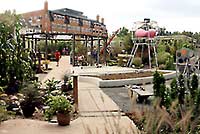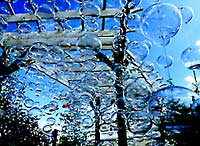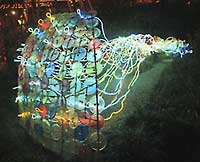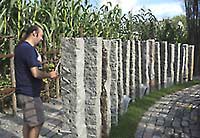Princeton University
Princeton Weekly Bulletin September 25, 2006, Vol. 96, No. 3 prev next current
- Page One
- • Tilghman charts path for the University’s future
- • University establishes new Center for African American Studies
- • Princeton to end early admission
- Special community ties section
- • Community and regional affairs office serves as bridge
- • Celebration this fall to mark 250 years of ‘Princeton in Princeton’
- • Community and Staff Day goes ‘under the lights’ at Princeton Stadium Oct. 13
- • University and local communities invited to join in ‘Plans in Progress’
- • Faculty, staff give back to the community through volunteer work
- • Collaboration with start-up company aims to improve efficiency of solar power
- • CAP shares academic riches with area residents
- • Center keeps pace with civic engagement opportunities
- • Community outreach generates a winning feeling for student-athletes
- • Cotsen materials go on the road
- • Trenton Program kindles passion for art
- Inside
- • Class of 2010 is most diverse in Princeton‘s history
- • Library exhibition celebrates Goheen
- • Science takes a walk in the park
- • Retiree Open Enrollment is Sept. 25-Oct. 6
- People
- • Humanities Council lines up roster of distinguished visitors
- • Eugenides, Thompson among new faculty members approved
- • Spotlight
- Almanac
- • Calendar of events
- • Nassau notes
- • By the numbers
- The Bulletin is published weekly during the academic year, except during University breaks and exam weeks, by the Office of Communications. Second class postage paid at Princeton. Postmaster: Send address changes to Princeton Weekly Bulletin, Office of Communications, Princeton University, 22 Chambers St., Suite 201, Princeton, NJ 08542. Permission is given to adapt, reprint or excerpt material from the Bulletin for use in other media.
- Subscriptions. The Bulletin is distributed free to faculty, staff and students. Others may subscribe to the Bulletin for $30 for the 2006-07 academic year (half price for current Princeton parents and people over 65). Send a check to Office of Communications, Princeton University, 22 Chambers St., Suite 201, Princeton, NJ 08542.
- Deadlines. In general, the copy deadline for each issue is the Friday 10 days in advance of the Monday cover date. The deadline for the Bulletin that covers Oct. 9-15 is Friday, Sept. 29. A complete publication schedule is available at www.princeton.edu/ pr/ pwb/ deadlines.html; or by calling (609) 258-3601.
- Editor: Ruth Stevens Calendar editor: Carolyn Geller Staff writers: Jennifer Greenstein Altmann, Eric Quiñones Contributing writer: Denise Barricklow, Cass Cliatt, Karin Dienst, Teresa Riordan Photographers: Denise Applewhite, John Jameson Design: Maggie Westergaard Web edition: Mahlon Lovett





Sculptures in Quark Park and the Princeton faculty members who inspired them include, from top: “Stellarator” (towering over the park), Robert Goldston; “Motion in the Ocean,” Naomi Leonard; “Sensation: Interior View,” President Tilghman and James Sturm; and “Augmented Lithophone,” Perry Cook (also shown in photo). For more information about Quark Park, visit www.princetonoccasion.org/quarkpark. (photos: Denise Applewhite)
Quark Park
Science takes a walk in the park
Princeton NJ — Nearly a dozen local artists have collaborated with 10 Princeton University scientists to create an enchanting sculpture garden called Quark Park that brings to life complex scientific concepts.
Sculptors, architects, landscape architects and a glass artist created renderings inspired by the work of Princeton president and molecular biologist Shirley M. Tilghman as well as professors Perry Cook, David Dobkin, Robert Goldston, Lincoln Hollister, Naomi Leonard, George Philander, George Scherer, Paul Steinhardt and James Sturm. Scientists from the Institute for Advanced Study, Rutgers University and private industry also are represented.
The park was built on the lot on Paul Robeson Place, between Chambers and Witherspoon streets, that was home to another garden project by the same creators two years ago. Writers Block was a verdant garden composed of inventive pavilions inspired by and dedicated to the work of 11 writers. The creators of both projects are landscape architects Alan Goodheart and Peter Soderman, and architect Kevin Wilkes.
For the second park, “science was the obvious choice, because there are so many scientists in Princeton and most scientists are relative aliens to the lay public,” said Soderman. “People don’t understand what scientists do.”
A sculpture near the entrance consists of twisted colored wires that travel from two small cone-like cages to a curved grid where dozens of plate-sized colored disks are mounted. Sculptor Nancy Cohen created the piece to illustrate the way mice perceive smells, inspired by research in Tilghman’s field. The colored wires, which represent the pathway from the nose to the brain, light up periodically, thanks to Sturm, the William and Edna Macaleer Professor of Engineering and Applied Science and director of the Princeton Institute for the Science and Technology of Materials. Sturm designed and installed the electroluminescent light wires along with the students in his lab and members of the electrical engineering department staff.
“These are meant to be an almost magical, surprising way to evoke the idea that a scent was perceived and is being sent back to the brain,” said Cohen, who was inspired by viewing photographs of scientific research on smell.
Rein Triefeldt, a kinetic sculptor, created an artistic rendering of the National Compact Stellarator Experiment under construction at the Princeton Plasma Physics Laboratory. The Stellarator will create a hot ionized gas called a plasma and use complex magnets to hold it in place. After visiting the PPPL, which is directed by Goldston, a professor of astrophysical sciences, and watching fusion experiments, Triefeldt, with help from the PPPL, built a 16-foot aluminum skeleton that soars above the park. Inside it floats a hot pink, doughnut-shaped object that represents the plasma.
Quark Park, which will host musical events and science demonstrations in the coming months, is supported by donations from the Office of the President and the Office of Community and Regional Affairs.

